Nursing Case Study: Managing Premenstrual Syndrome Symptoms in Tracey
VerifiedAdded on 2023/06/05
|8
|1988
|133
Case Study
AI Summary
This nursing case study delves into the pathophysiology of premenstrual syndrome (PMS) using the case of Tracey, who experiences a range of physical and emotional symptoms one week before her menses. The study explores potential causes of PMS, including hormonal fluctuations and neurotransmitter imbalances, and differentiates PMS from conditions like polycystic ovary syndrome. It further discusses various treatment approaches, including lifestyle modifications such as smoking cessation, exercise, and dietary changes, as well as pharmaceutical interventions like antidepressants, NSAIDs, and hormonal contraceptives. The case emphasizes the importance of accurate diagnosis and personalized treatment plans to effectively manage PMS symptoms and improve the patient's quality of life. Desklib offers a wealth of similar solved assignments and past papers for students.
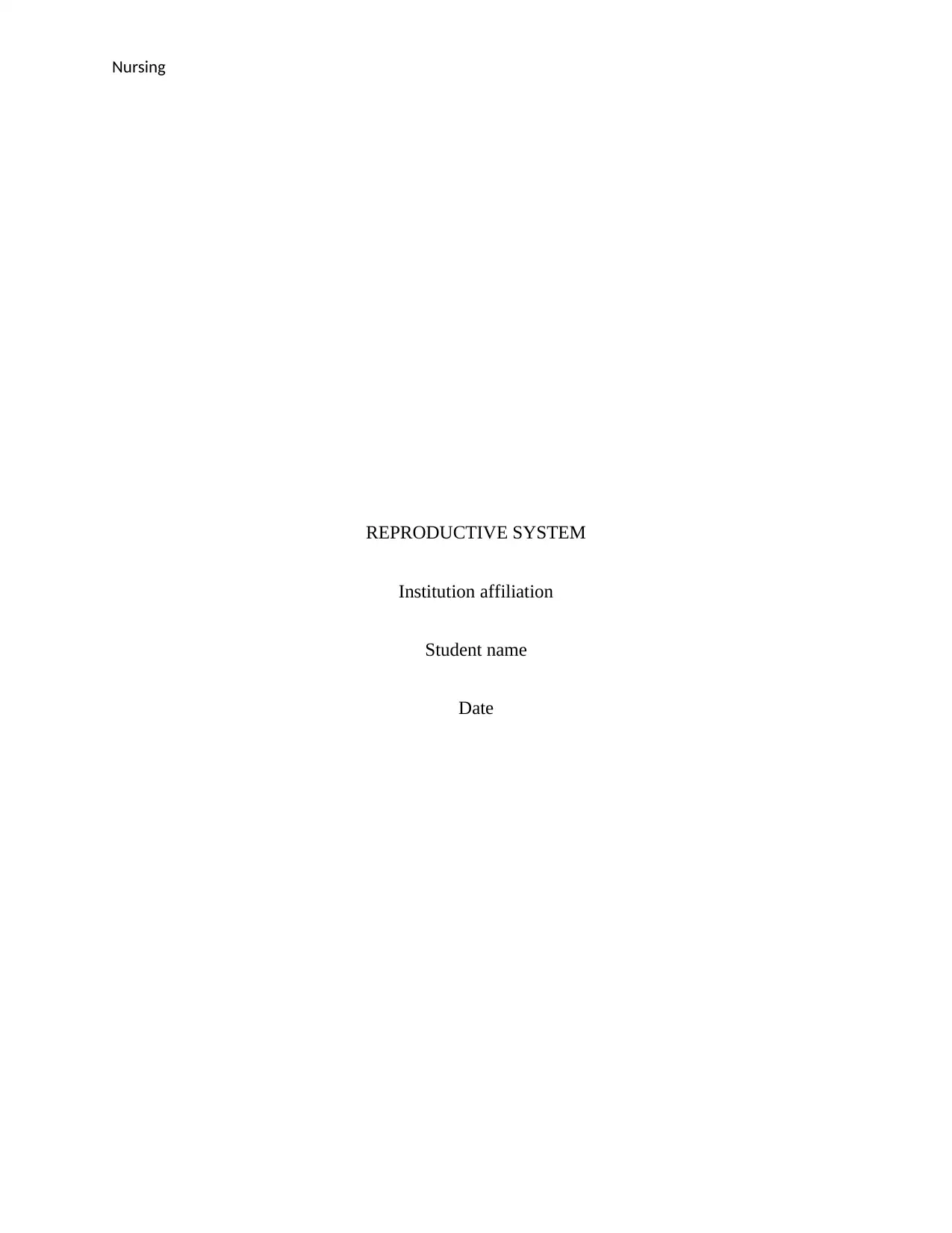
Nursing
REPRODUCTIVE SYSTEM
Institution affiliation
Student name
Date
REPRODUCTIVE SYSTEM
Institution affiliation
Student name
Date
Paraphrase This Document
Need a fresh take? Get an instant paraphrase of this document with our AI Paraphraser

Nursing
Explaining the pathophysiology of premenstrual syndrome symptoms about Tracey's case
study
Premenstrual syndrome is defined as physical and emotional signs and symptoms which
occur in one or two weeks before a woman experiences her periods(Schellenberg, Zimmermann,
Drewe, Hoexter&Zahner, 2012), while pathophysiology is the combination of two words
pathology and physiology. Pathology refers to a medical discipline describing undesirable
condition observable during the state of disease. For instance, Tracey had severe urinary tract
infection 13 years ago. On the other hand, physiology is referred to as a biological discipline
describing a process that operates in an organism. They are different depending on a woman and
revolve around the start of bleeding(Samadi, Taghian&Valiani, 2013). Pathophysiology
describes functional changes that occur within an individual as a result of pathogenic state or
disease. From the case study, Tracey symptoms are predictable and occur three days or one week
before her menses. This has been happening in her last three monthly menses.
Women with premenstrual syndrome may experience, behavioral and Emotional signs
and symptoms which includes, food craving, changes in appetite, anger and irritability, mood
swings, mood and depression, anxiety and Tension, lack of sleep (insomnia), inability to
socialize, Change in libido(Samadi, Taghian&Valiani, 2013). Tracey reports most of these
emotional symptoms to Belmont private hospital.
Common causes of premenstrual syndrome
It is the right time to see a doctor if premenstrual signs and symptoms become
unmanageable and affect your daily life's activities(Chung et al., 2014).
Explaining the pathophysiology of premenstrual syndrome symptoms about Tracey's case
study
Premenstrual syndrome is defined as physical and emotional signs and symptoms which
occur in one or two weeks before a woman experiences her periods(Schellenberg, Zimmermann,
Drewe, Hoexter&Zahner, 2012), while pathophysiology is the combination of two words
pathology and physiology. Pathology refers to a medical discipline describing undesirable
condition observable during the state of disease. For instance, Tracey had severe urinary tract
infection 13 years ago. On the other hand, physiology is referred to as a biological discipline
describing a process that operates in an organism. They are different depending on a woman and
revolve around the start of bleeding(Samadi, Taghian&Valiani, 2013). Pathophysiology
describes functional changes that occur within an individual as a result of pathogenic state or
disease. From the case study, Tracey symptoms are predictable and occur three days or one week
before her menses. This has been happening in her last three monthly menses.
Women with premenstrual syndrome may experience, behavioral and Emotional signs
and symptoms which includes, food craving, changes in appetite, anger and irritability, mood
swings, mood and depression, anxiety and Tension, lack of sleep (insomnia), inability to
socialize, Change in libido(Samadi, Taghian&Valiani, 2013). Tracey reports most of these
emotional symptoms to Belmont private hospital.
Common causes of premenstrual syndrome
It is the right time to see a doctor if premenstrual signs and symptoms become
unmanageable and affect your daily life's activities(Chung et al., 2014).
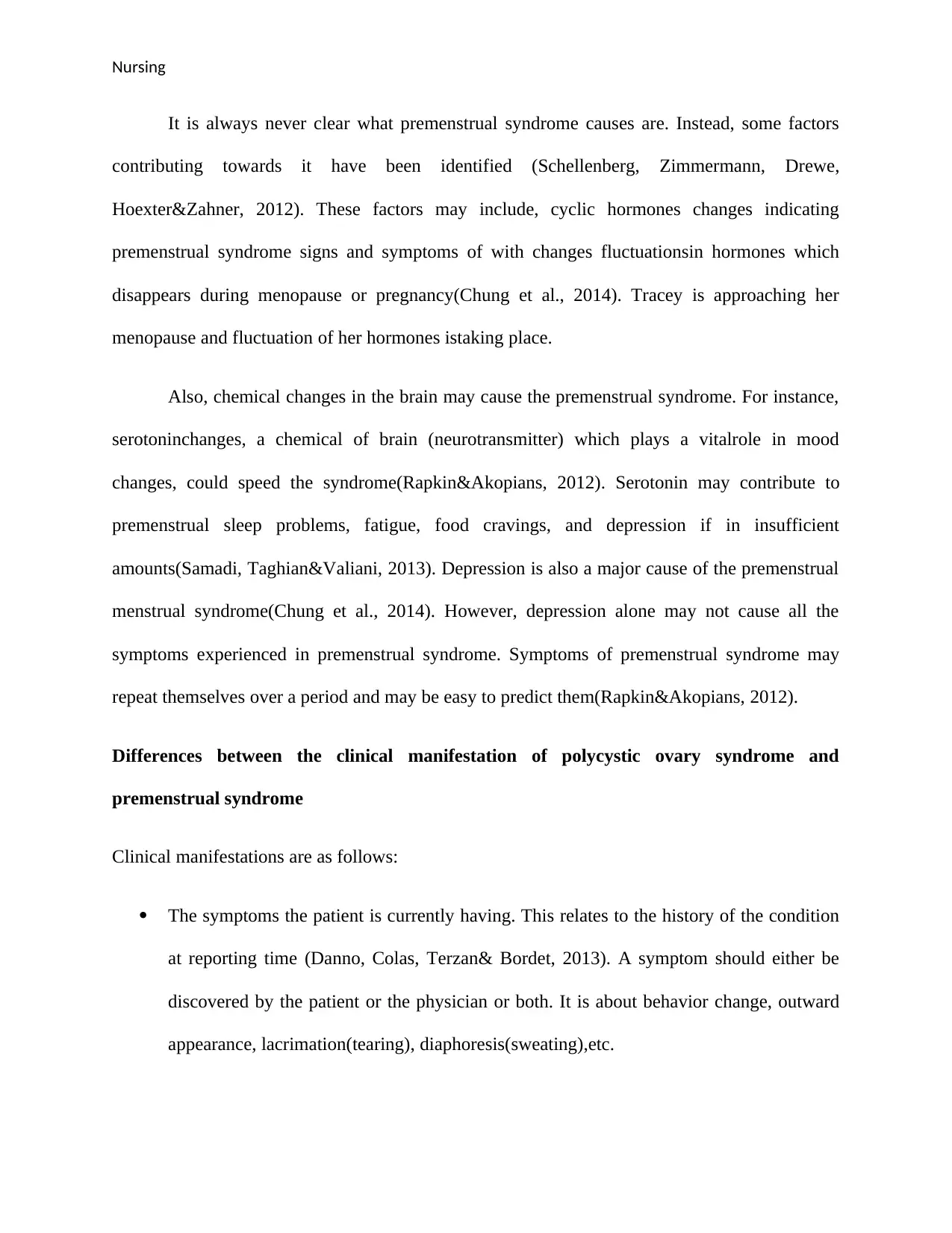
Nursing
It is always never clear what premenstrual syndrome causes are. Instead, some factors
contributing towards it have been identified (Schellenberg, Zimmermann, Drewe,
Hoexter&Zahner, 2012). These factors may include, cyclic hormones changes indicating
premenstrual syndrome signs and symptoms of with changes fluctuationsin hormones which
disappears during menopause or pregnancy(Chung et al., 2014). Tracey is approaching her
menopause and fluctuation of her hormones istaking place.
Also, chemical changes in the brain may cause the premenstrual syndrome. For instance,
serotoninchanges, a chemical of brain (neurotransmitter) which plays a vitalrole in mood
changes, could speed the syndrome(Rapkin&Akopians, 2012). Serotonin may contribute to
premenstrual sleep problems, fatigue, food cravings, and depression if in insufficient
amounts(Samadi, Taghian&Valiani, 2013). Depression is also a major cause of the premenstrual
menstrual syndrome(Chung et al., 2014). However, depression alone may not cause all the
symptoms experienced in premenstrual syndrome. Symptoms of premenstrual syndrome may
repeat themselves over a period and may be easy to predict them(Rapkin&Akopians, 2012).
Differences between the clinical manifestation of polycystic ovary syndrome and
premenstrual syndrome
Clinical manifestations are as follows:
The symptoms the patient is currently having. This relates to the history of the condition
at reporting time (Danno, Colas, Terzan& Bordet, 2013). A symptom should either be
discovered by the patient or the physician or both. It is about behavior change, outward
appearance, lacrimation(tearing), diaphoresis(sweating),etc.
It is always never clear what premenstrual syndrome causes are. Instead, some factors
contributing towards it have been identified (Schellenberg, Zimmermann, Drewe,
Hoexter&Zahner, 2012). These factors may include, cyclic hormones changes indicating
premenstrual syndrome signs and symptoms of with changes fluctuationsin hormones which
disappears during menopause or pregnancy(Chung et al., 2014). Tracey is approaching her
menopause and fluctuation of her hormones istaking place.
Also, chemical changes in the brain may cause the premenstrual syndrome. For instance,
serotoninchanges, a chemical of brain (neurotransmitter) which plays a vitalrole in mood
changes, could speed the syndrome(Rapkin&Akopians, 2012). Serotonin may contribute to
premenstrual sleep problems, fatigue, food cravings, and depression if in insufficient
amounts(Samadi, Taghian&Valiani, 2013). Depression is also a major cause of the premenstrual
menstrual syndrome(Chung et al., 2014). However, depression alone may not cause all the
symptoms experienced in premenstrual syndrome. Symptoms of premenstrual syndrome may
repeat themselves over a period and may be easy to predict them(Rapkin&Akopians, 2012).
Differences between the clinical manifestation of polycystic ovary syndrome and
premenstrual syndrome
Clinical manifestations are as follows:
The symptoms the patient is currently having. This relates to the history of the condition
at reporting time (Danno, Colas, Terzan& Bordet, 2013). A symptom should either be
discovered by the patient or the physician or both. It is about behavior change, outward
appearance, lacrimation(tearing), diaphoresis(sweating),etc.
⊘ This is a preview!⊘
Do you want full access?
Subscribe today to unlock all pages.

Trusted by 1+ million students worldwide
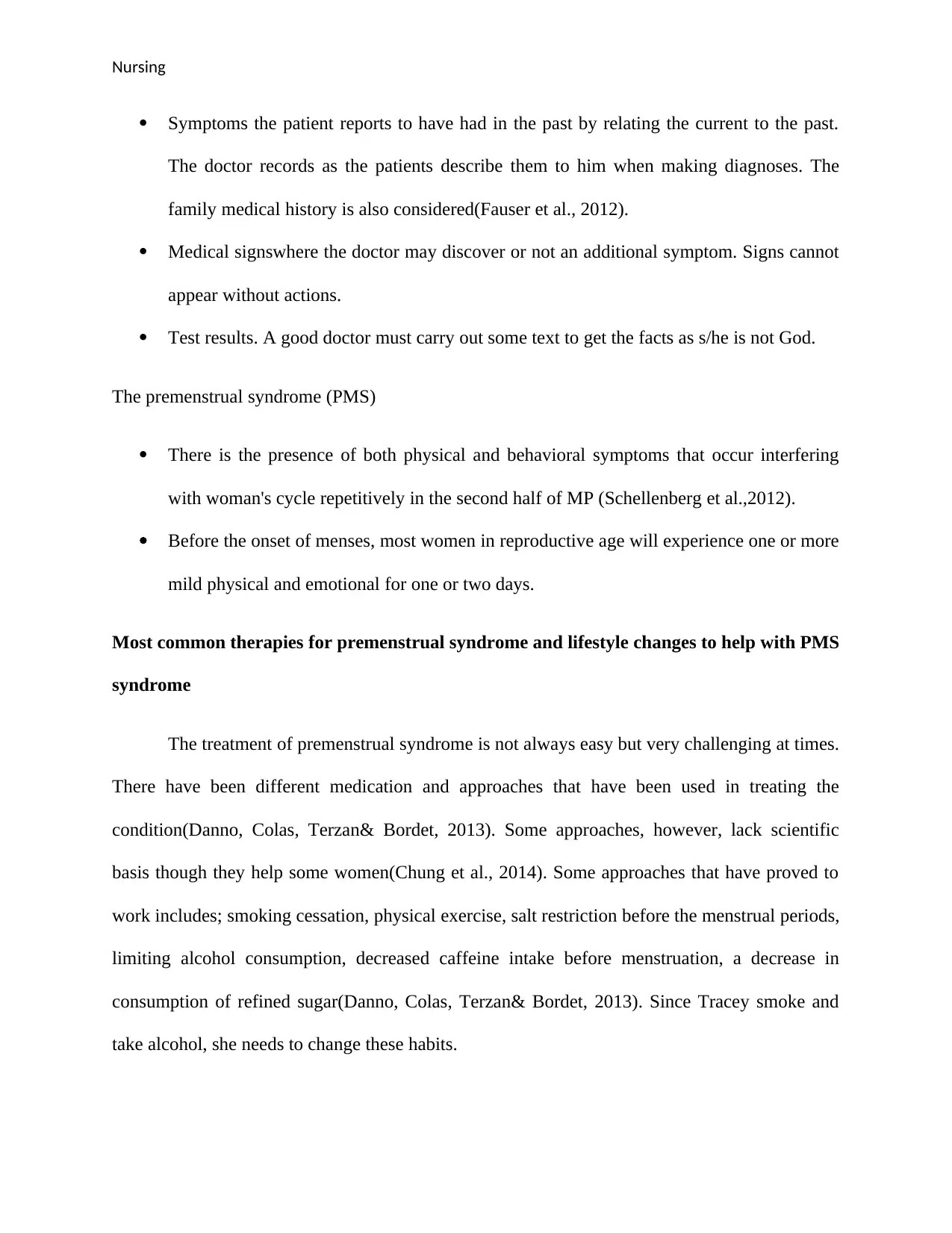
Nursing
Symptoms the patient reports to have had in the past by relating the current to the past.
The doctor records as the patients describe them to him when making diagnoses. The
family medical history is also considered(Fauser et al., 2012).
Medical signswhere the doctor may discover or not an additional symptom. Signs cannot
appear without actions.
Test results. A good doctor must carry out some text to get the facts as s/he is not God.
The premenstrual syndrome (PMS)
There is the presence of both physical and behavioral symptoms that occur interfering
with woman's cycle repetitively in the second half of MP (Schellenberg et al.,2012).
Before the onset of menses, most women in reproductive age will experience one or more
mild physical and emotional for one or two days.
Most common therapies for premenstrual syndrome and lifestyle changes to help with PMS
syndrome
The treatment of premenstrual syndrome is not always easy but very challenging at times.
There have been different medication and approaches that have been used in treating the
condition(Danno, Colas, Terzan& Bordet, 2013). Some approaches, however, lack scientific
basis though they help some women(Chung et al., 2014). Some approaches that have proved to
work includes; smoking cessation, physical exercise, salt restriction before the menstrual periods,
limiting alcohol consumption, decreased caffeine intake before menstruation, a decrease in
consumption of refined sugar(Danno, Colas, Terzan& Bordet, 2013). Since Tracey smoke and
take alcohol, she needs to change these habits.
Symptoms the patient reports to have had in the past by relating the current to the past.
The doctor records as the patients describe them to him when making diagnoses. The
family medical history is also considered(Fauser et al., 2012).
Medical signswhere the doctor may discover or not an additional symptom. Signs cannot
appear without actions.
Test results. A good doctor must carry out some text to get the facts as s/he is not God.
The premenstrual syndrome (PMS)
There is the presence of both physical and behavioral symptoms that occur interfering
with woman's cycle repetitively in the second half of MP (Schellenberg et al.,2012).
Before the onset of menses, most women in reproductive age will experience one or more
mild physical and emotional for one or two days.
Most common therapies for premenstrual syndrome and lifestyle changes to help with PMS
syndrome
The treatment of premenstrual syndrome is not always easy but very challenging at times.
There have been different medication and approaches that have been used in treating the
condition(Danno, Colas, Terzan& Bordet, 2013). Some approaches, however, lack scientific
basis though they help some women(Chung et al., 2014). Some approaches that have proved to
work includes; smoking cessation, physical exercise, salt restriction before the menstrual periods,
limiting alcohol consumption, decreased caffeine intake before menstruation, a decrease in
consumption of refined sugar(Danno, Colas, Terzan& Bordet, 2013). Since Tracey smoke and
take alcohol, she needs to change these habits.
Paraphrase This Document
Need a fresh take? Get an instant paraphrase of this document with our AI Paraphraser
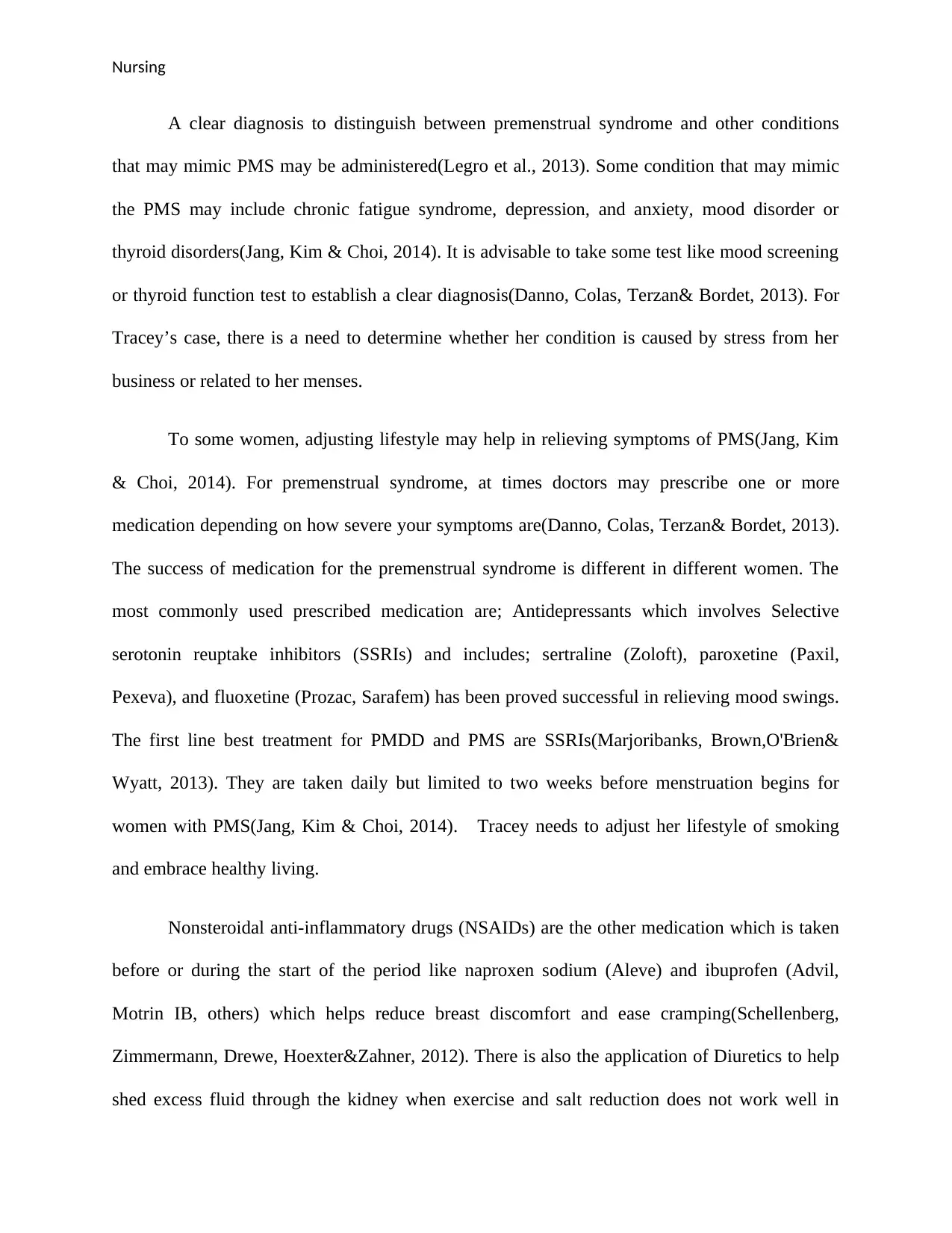
Nursing
A clear diagnosis to distinguish between premenstrual syndrome and other conditions
that may mimic PMS may be administered(Legro et al., 2013). Some condition that may mimic
the PMS may include chronic fatigue syndrome, depression, and anxiety, mood disorder or
thyroid disorders(Jang, Kim & Choi, 2014). It is advisable to take some test like mood screening
or thyroid function test to establish a clear diagnosis(Danno, Colas, Terzan& Bordet, 2013). For
Tracey’s case, there is a need to determine whether her condition is caused by stress from her
business or related to her menses.
To some women, adjusting lifestyle may help in relieving symptoms of PMS(Jang, Kim
& Choi, 2014). For premenstrual syndrome, at times doctors may prescribe one or more
medication depending on how severe your symptoms are(Danno, Colas, Terzan& Bordet, 2013).
The success of medication for the premenstrual syndrome is different in different women. The
most commonly used prescribed medication are; Antidepressants which involves Selective
serotonin reuptake inhibitors (SSRIs) and includes; sertraline (Zoloft), paroxetine (Paxil,
Pexeva), and fluoxetine (Prozac, Sarafem) has been proved successful in relieving mood swings.
The first line best treatment for PMDD and PMS are SSRIs(Marjoribanks, Brown,O'Brien&
Wyatt, 2013). They are taken daily but limited to two weeks before menstruation begins for
women with PMS(Jang, Kim & Choi, 2014). Tracey needs to adjust her lifestyle of smoking
and embrace healthy living.
Nonsteroidal anti-inflammatory drugs (NSAIDs) are the other medication which is taken
before or during the start of the period like naproxen sodium (Aleve) and ibuprofen (Advil,
Motrin IB, others) which helps reduce breast discomfort and ease cramping(Schellenberg,
Zimmermann, Drewe, Hoexter&Zahner, 2012). There is also the application of Diuretics to help
shed excess fluid through the kidney when exercise and salt reduction does not work well in
A clear diagnosis to distinguish between premenstrual syndrome and other conditions
that may mimic PMS may be administered(Legro et al., 2013). Some condition that may mimic
the PMS may include chronic fatigue syndrome, depression, and anxiety, mood disorder or
thyroid disorders(Jang, Kim & Choi, 2014). It is advisable to take some test like mood screening
or thyroid function test to establish a clear diagnosis(Danno, Colas, Terzan& Bordet, 2013). For
Tracey’s case, there is a need to determine whether her condition is caused by stress from her
business or related to her menses.
To some women, adjusting lifestyle may help in relieving symptoms of PMS(Jang, Kim
& Choi, 2014). For premenstrual syndrome, at times doctors may prescribe one or more
medication depending on how severe your symptoms are(Danno, Colas, Terzan& Bordet, 2013).
The success of medication for the premenstrual syndrome is different in different women. The
most commonly used prescribed medication are; Antidepressants which involves Selective
serotonin reuptake inhibitors (SSRIs) and includes; sertraline (Zoloft), paroxetine (Paxil,
Pexeva), and fluoxetine (Prozac, Sarafem) has been proved successful in relieving mood swings.
The first line best treatment for PMDD and PMS are SSRIs(Marjoribanks, Brown,O'Brien&
Wyatt, 2013). They are taken daily but limited to two weeks before menstruation begins for
women with PMS(Jang, Kim & Choi, 2014). Tracey needs to adjust her lifestyle of smoking
and embrace healthy living.
Nonsteroidal anti-inflammatory drugs (NSAIDs) are the other medication which is taken
before or during the start of the period like naproxen sodium (Aleve) and ibuprofen (Advil,
Motrin IB, others) which helps reduce breast discomfort and ease cramping(Schellenberg,
Zimmermann, Drewe, Hoexter&Zahner, 2012). There is also the application of Diuretics to help
shed excess fluid through the kidney when exercise and salt reduction does not work well in
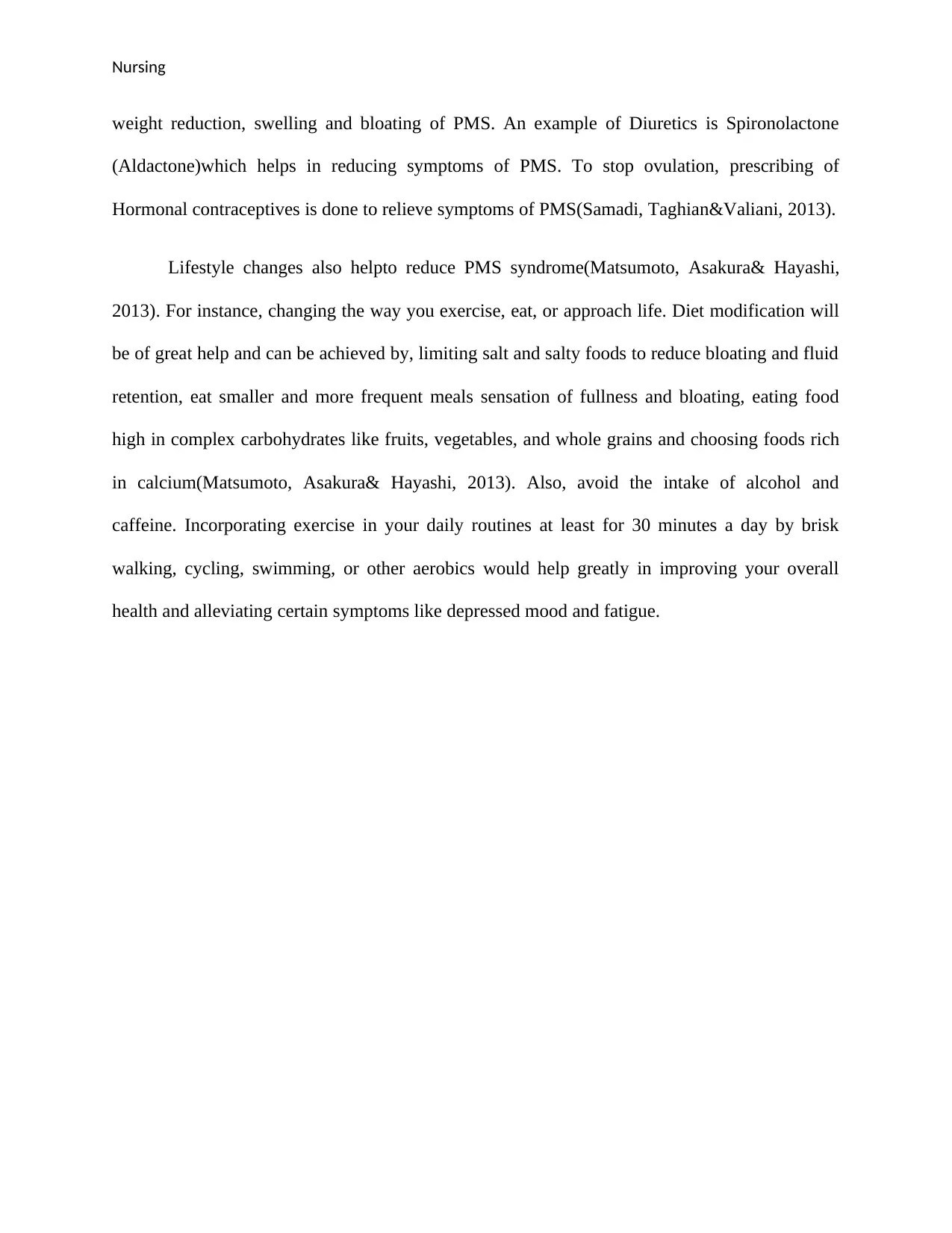
Nursing
weight reduction, swelling and bloating of PMS. An example of Diuretics is Spironolactone
(Aldactone)which helps in reducing symptoms of PMS. To stop ovulation, prescribing of
Hormonal contraceptives is done to relieve symptoms of PMS(Samadi, Taghian&Valiani, 2013).
Lifestyle changes also helpto reduce PMS syndrome(Matsumoto, Asakura& Hayashi,
2013). For instance, changing the way you exercise, eat, or approach life. Diet modification will
be of great help and can be achieved by, limiting salt and salty foods to reduce bloating and fluid
retention, eat smaller and more frequent meals sensation of fullness and bloating, eating food
high in complex carbohydrates like fruits, vegetables, and whole grains and choosing foods rich
in calcium(Matsumoto, Asakura& Hayashi, 2013). Also, avoid the intake of alcohol and
caffeine. Incorporating exercise in your daily routines at least for 30 minutes a day by brisk
walking, cycling, swimming, or other aerobics would help greatly in improving your overall
health and alleviating certain symptoms like depressed mood and fatigue.
weight reduction, swelling and bloating of PMS. An example of Diuretics is Spironolactone
(Aldactone)which helps in reducing symptoms of PMS. To stop ovulation, prescribing of
Hormonal contraceptives is done to relieve symptoms of PMS(Samadi, Taghian&Valiani, 2013).
Lifestyle changes also helpto reduce PMS syndrome(Matsumoto, Asakura& Hayashi,
2013). For instance, changing the way you exercise, eat, or approach life. Diet modification will
be of great help and can be achieved by, limiting salt and salty foods to reduce bloating and fluid
retention, eat smaller and more frequent meals sensation of fullness and bloating, eating food
high in complex carbohydrates like fruits, vegetables, and whole grains and choosing foods rich
in calcium(Matsumoto, Asakura& Hayashi, 2013). Also, avoid the intake of alcohol and
caffeine. Incorporating exercise in your daily routines at least for 30 minutes a day by brisk
walking, cycling, swimming, or other aerobics would help greatly in improving your overall
health and alleviating certain symptoms like depressed mood and fatigue.
⊘ This is a preview!⊘
Do you want full access?
Subscribe today to unlock all pages.

Trusted by 1+ million students worldwide
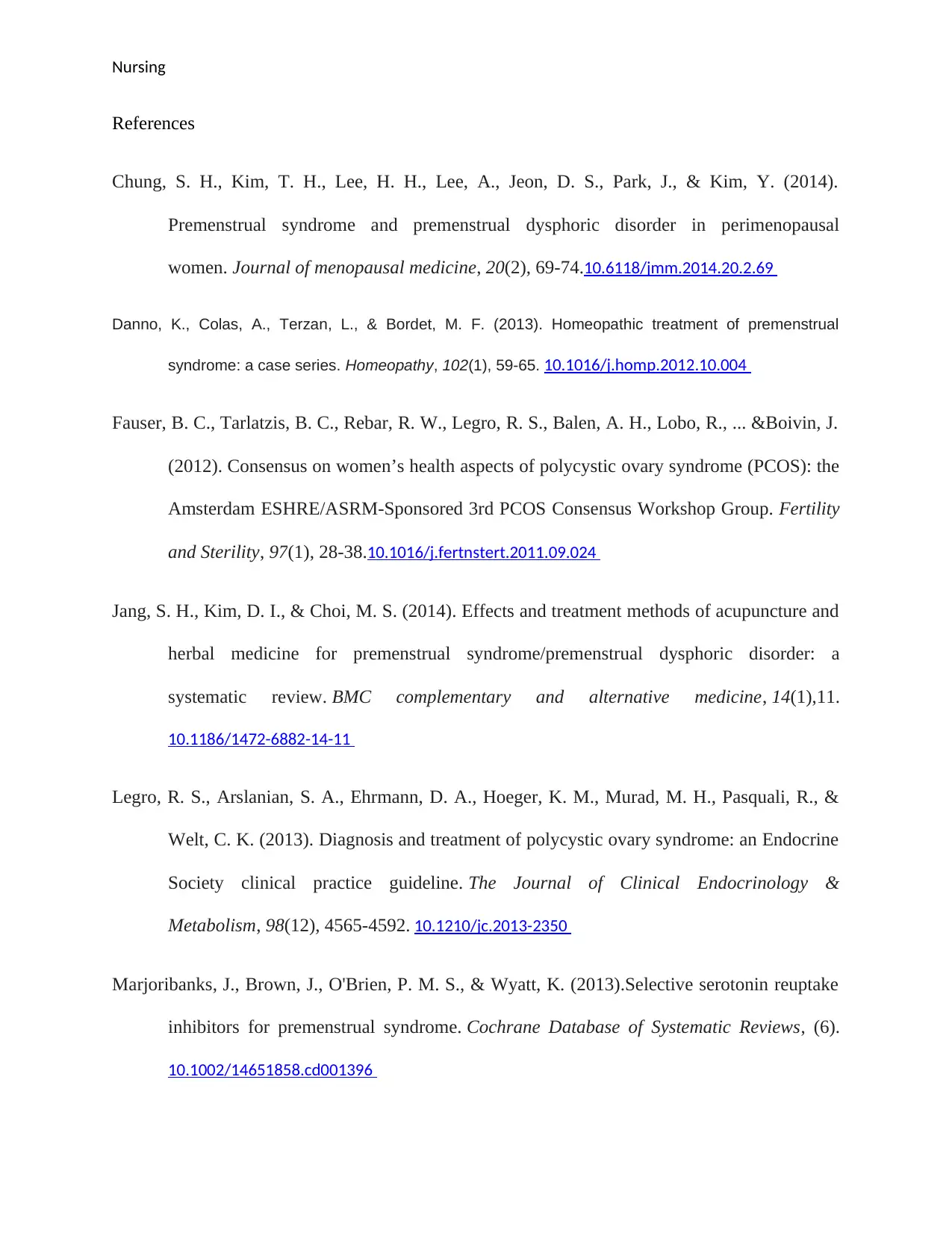
Nursing
References
Chung, S. H., Kim, T. H., Lee, H. H., Lee, A., Jeon, D. S., Park, J., & Kim, Y. (2014).
Premenstrual syndrome and premenstrual dysphoric disorder in perimenopausal
women. Journal of menopausal medicine, 20(2), 69-74.10.6118/jmm.2014.20.2.69
Danno, K., Colas, A., Terzan, L., & Bordet, M. F. (2013). Homeopathic treatment of premenstrual
syndrome: a case series. Homeopathy, 102(1), 59-65. 10.1016/j.homp.2012.10.004
Fauser, B. C., Tarlatzis, B. C., Rebar, R. W., Legro, R. S., Balen, A. H., Lobo, R., ... &Boivin, J.
(2012). Consensus on women’s health aspects of polycystic ovary syndrome (PCOS): the
Amsterdam ESHRE/ASRM-Sponsored 3rd PCOS Consensus Workshop Group. Fertility
and Sterility, 97(1), 28-38.10.1016/j.fertnstert.2011.09.024
Jang, S. H., Kim, D. I., & Choi, M. S. (2014). Effects and treatment methods of acupuncture and
herbal medicine for premenstrual syndrome/premenstrual dysphoric disorder: a
systematic review. BMC complementary and alternative medicine, 14(1),11.
10.1186/1472-6882-14-11
Legro, R. S., Arslanian, S. A., Ehrmann, D. A., Hoeger, K. M., Murad, M. H., Pasquali, R., &
Welt, C. K. (2013). Diagnosis and treatment of polycystic ovary syndrome: an Endocrine
Society clinical practice guideline. The Journal of Clinical Endocrinology &
Metabolism, 98(12), 4565-4592. 10.1210/jc.2013-2350
Marjoribanks, J., Brown, J., O'Brien, P. M. S., & Wyatt, K. (2013).Selective serotonin reuptake
inhibitors for premenstrual syndrome. Cochrane Database of Systematic Reviews, (6).
10.1002/14651858.cd001396
References
Chung, S. H., Kim, T. H., Lee, H. H., Lee, A., Jeon, D. S., Park, J., & Kim, Y. (2014).
Premenstrual syndrome and premenstrual dysphoric disorder in perimenopausal
women. Journal of menopausal medicine, 20(2), 69-74.10.6118/jmm.2014.20.2.69
Danno, K., Colas, A., Terzan, L., & Bordet, M. F. (2013). Homeopathic treatment of premenstrual
syndrome: a case series. Homeopathy, 102(1), 59-65. 10.1016/j.homp.2012.10.004
Fauser, B. C., Tarlatzis, B. C., Rebar, R. W., Legro, R. S., Balen, A. H., Lobo, R., ... &Boivin, J.
(2012). Consensus on women’s health aspects of polycystic ovary syndrome (PCOS): the
Amsterdam ESHRE/ASRM-Sponsored 3rd PCOS Consensus Workshop Group. Fertility
and Sterility, 97(1), 28-38.10.1016/j.fertnstert.2011.09.024
Jang, S. H., Kim, D. I., & Choi, M. S. (2014). Effects and treatment methods of acupuncture and
herbal medicine for premenstrual syndrome/premenstrual dysphoric disorder: a
systematic review. BMC complementary and alternative medicine, 14(1),11.
10.1186/1472-6882-14-11
Legro, R. S., Arslanian, S. A., Ehrmann, D. A., Hoeger, K. M., Murad, M. H., Pasquali, R., &
Welt, C. K. (2013). Diagnosis and treatment of polycystic ovary syndrome: an Endocrine
Society clinical practice guideline. The Journal of Clinical Endocrinology &
Metabolism, 98(12), 4565-4592. 10.1210/jc.2013-2350
Marjoribanks, J., Brown, J., O'Brien, P. M. S., & Wyatt, K. (2013).Selective serotonin reuptake
inhibitors for premenstrual syndrome. Cochrane Database of Systematic Reviews, (6).
10.1002/14651858.cd001396
Paraphrase This Document
Need a fresh take? Get an instant paraphrase of this document with our AI Paraphraser
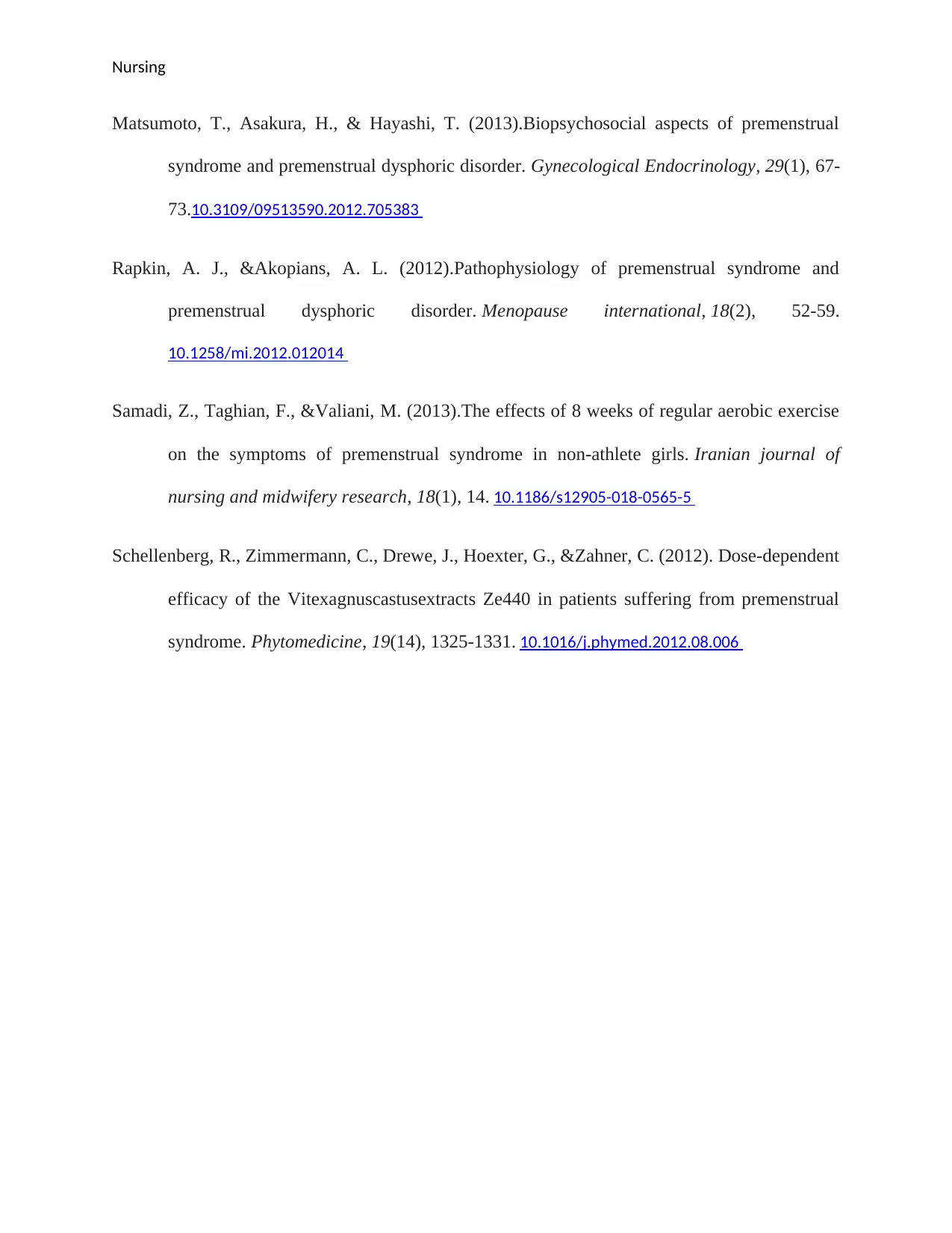
Nursing
Matsumoto, T., Asakura, H., & Hayashi, T. (2013).Biopsychosocial aspects of premenstrual
syndrome and premenstrual dysphoric disorder. Gynecological Endocrinology, 29(1), 67-
73.10.3109/09513590.2012.705383
Rapkin, A. J., &Akopians, A. L. (2012).Pathophysiology of premenstrual syndrome and
premenstrual dysphoric disorder. Menopause international, 18(2), 52-59.
10.1258/mi.2012.012014
Samadi, Z., Taghian, F., &Valiani, M. (2013).The effects of 8 weeks of regular aerobic exercise
on the symptoms of premenstrual syndrome in non-athlete girls. Iranian journal of
nursing and midwifery research, 18(1), 14. 10.1186/s12905-018-0565-5
Schellenberg, R., Zimmermann, C., Drewe, J., Hoexter, G., &Zahner, C. (2012). Dose-dependent
efficacy of the Vitexagnuscastusextracts Ze440 in patients suffering from premenstrual
syndrome. Phytomedicine, 19(14), 1325-1331. 10.1016/j.phymed.2012.08.006
Matsumoto, T., Asakura, H., & Hayashi, T. (2013).Biopsychosocial aspects of premenstrual
syndrome and premenstrual dysphoric disorder. Gynecological Endocrinology, 29(1), 67-
73.10.3109/09513590.2012.705383
Rapkin, A. J., &Akopians, A. L. (2012).Pathophysiology of premenstrual syndrome and
premenstrual dysphoric disorder. Menopause international, 18(2), 52-59.
10.1258/mi.2012.012014
Samadi, Z., Taghian, F., &Valiani, M. (2013).The effects of 8 weeks of regular aerobic exercise
on the symptoms of premenstrual syndrome in non-athlete girls. Iranian journal of
nursing and midwifery research, 18(1), 14. 10.1186/s12905-018-0565-5
Schellenberg, R., Zimmermann, C., Drewe, J., Hoexter, G., &Zahner, C. (2012). Dose-dependent
efficacy of the Vitexagnuscastusextracts Ze440 in patients suffering from premenstrual
syndrome. Phytomedicine, 19(14), 1325-1331. 10.1016/j.phymed.2012.08.006
1 out of 8
Related Documents
Your All-in-One AI-Powered Toolkit for Academic Success.
+13062052269
info@desklib.com
Available 24*7 on WhatsApp / Email
![[object Object]](/_next/static/media/star-bottom.7253800d.svg)
Unlock your academic potential
Copyright © 2020–2025 A2Z Services. All Rights Reserved. Developed and managed by ZUCOL.



